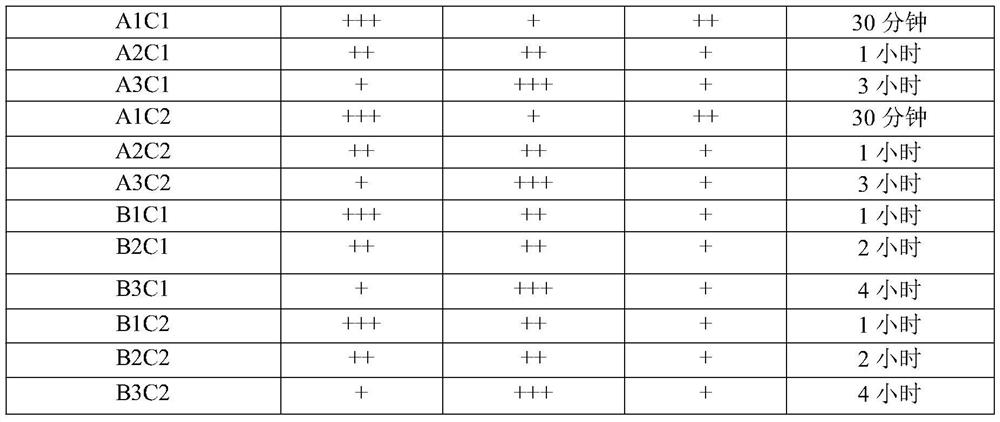A kind of method adopting sodium alginate to carry out pathological film preparation
A sodium alginate and pathological technology, applied in the field of pathological diagnosis, can solve the problems of difficult diagnosis, small amount of tissue cells in specimens, and difficulty in obtaining tissue specimens, and achieve the effect of improving the accuracy of diagnosis
- Summary
- Abstract
- Description
- Claims
- Application Information
AI Technical Summary
Problems solved by technology
Method used
Image
Examples
Embodiment 1
[0017] The concentration of each substance added was divided into the following groups, and the specific results are shown in Table 1.
[0018] Table 1
[0019]
[0020] Take 2ml of calcium chloride solution, quickly add 1ml of sodium alginate solution, shake well and let it stand for 30 seconds to form a ball, then pour it out, pump out the liquid in the ball, inject 0.5ml of tissue cell suspension, wrap it with gauze and put it in The embedding cassettes were dehydrated and sliced.
[0021] Wherein, the preparation method of isopropanol sodium alginate is as follows: first prepare 0.5%, 1%, 3% sodium alginate solution, and then add 0.1 ml of isopropanol to 10 ml of the above-mentioned concentration of sodium alginate solution.
[0022] Set the groups shown in Table 2 according to the concentrations in Table 1, and measure the ball forming, residue, dyeing effect and fixation time.
[0023] Table 2
[0024]
[0025]
[0026] In the table above:
[0027]
[002...
Embodiment 2
[0030] The concentration of each substance added was divided into the following groups, and the specific results are shown in Table 3.
[0031] table 3
[0032]
[0033] Add 1ml of sodium alginate solution into the round hole of the mold, inject 0.5ml of eosin-stained tissue cell suspension, immediately put it into 2ml of calcium chloride ethanol glacial acetic acid solution to form a gel, wrap it with gauze and put it into the embedding box Carry out dehydration and tablet making.
[0034] Set the groups shown in Table 4 according to the concentration in Table 3, and measure the ball forming, residue, dyeing effect and fixation time.
[0035] Table 4
[0036] Packaged residual Dyeing effect post-fixation time A1D3 +++ + +++ 30 minutes A2D3 +++ + ++ 30 minutes
[0037] The results showed that after wrapping the cells with sodium alginate and fixing them for a short period of time, good results could be achieved. There will be a s...
Embodiment 3
[0039] The added concentration of each substance was divided into the following groups, and the specific results are shown in Table 5.
[0040] table 5
[0041]
[0042] Take a liquid sample containing cell tissue, add eosin for staining, centrifuge at 2000 rpm for 3 minutes, discard the supernatant, keep 0.5ml of the precipitate, directly add 0.5ml of sodium alginate solution to cover the precipitate, and then add 2ml of calcium chloride solution Shape the gel, wrap it with gauze and put it into the embedding box for dehydration and tablet production.
[0043] Set the groups shown in Table 6 according to the concentration in Table 5, and measure the ball forming, residue, dyeing effect and fixation time.
[0044] Table 6
[0045] Packaged residual Dyeing effect post-fixation time A1C3 +++ + / - +++ 30 minutes A2C3 +++ + / - ++ 30 minutes
[0046] where residual + / - extremely low
PUM
| Property | Measurement | Unit |
|---|---|---|
| quality score | aaaaa | aaaaa |
Abstract
Description
Claims
Application Information
 Login to View More
Login to View More - R&D
- Intellectual Property
- Life Sciences
- Materials
- Tech Scout
- Unparalleled Data Quality
- Higher Quality Content
- 60% Fewer Hallucinations
Browse by: Latest US Patents, China's latest patents, Technical Efficacy Thesaurus, Application Domain, Technology Topic, Popular Technical Reports.
© 2025 PatSnap. All rights reserved.Legal|Privacy policy|Modern Slavery Act Transparency Statement|Sitemap|About US| Contact US: help@patsnap.com



